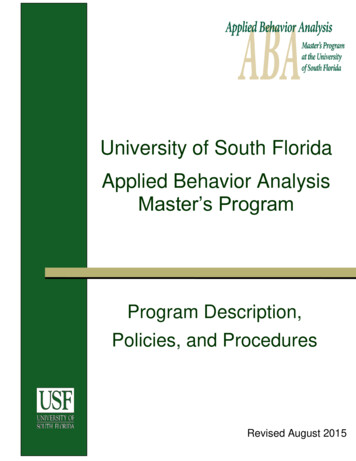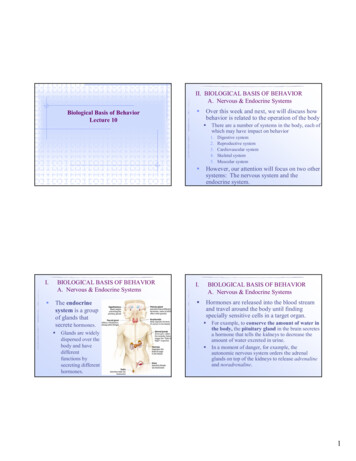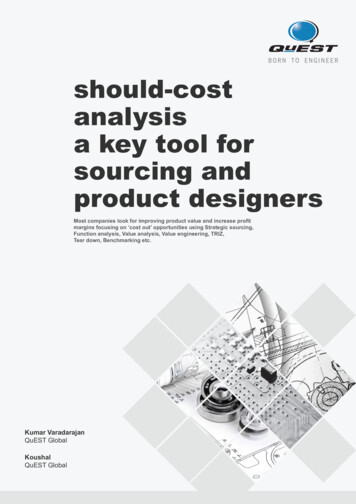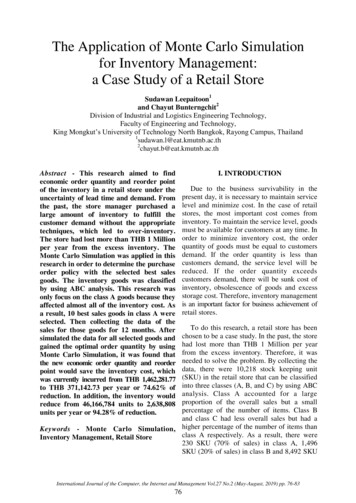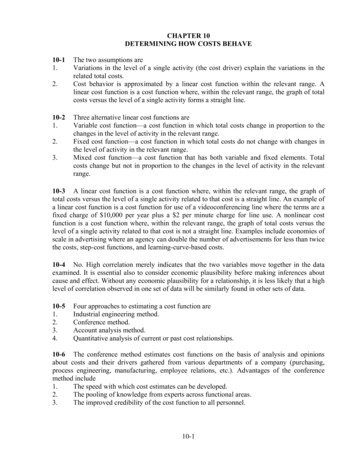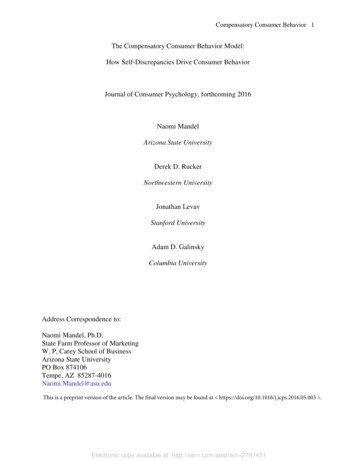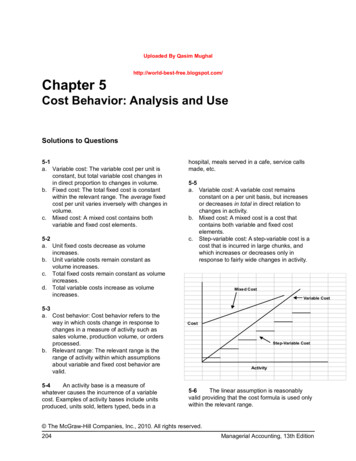
Transcription
Uploaded By Qasim Mughalhttp://world-best-free.blogspot.com/Chapter 5Cost Behavior: Analysis and UseSolutions to Questions5-1a. Variable cost: The variable cost per unit isconstant, but total variable cost changes inin direct proportion to changes in volume.b. Fixed cost: The total fixed cost is constantwithin the relevant range. The average fixedcost per unit varies inversely with changes involume.c. Mixed cost: A mixed cost contains bothvariable and fixed cost elements.5-2a. Unit fixed costs decrease as volumeincreases.b. Unit variable costs remain constant asvolume increases.c. Total fixed costs remain constant as volumeincreases.d. Total variable costs increase as volumeincreases.5-3a. Cost behavior: Cost behavior refers to theway in which costs change in response tochanges in a measure of activity such assales volume, production volume, or ordersprocessed.b. Relevant range: The relevant range is therange of activity within which assumptionsabout variable and fixed cost behavior arevalid.5-4An activity base is a measure ofwhatever causes the incurrence of a variablecost. Examples of activity bases include unitsproduced, units sold, letters typed, beds in ahospital, meals served in a cafe, service callsmade, etc.5-5a. Variable cost: A variable cost remainsconstant on a per unit basis, but increasesor decreases in total in direct relation tochanges in activity.b. Mixed cost: A mixed cost is a cost thatcontains both variable and fixed costelements.c. Step-variable cost: A step-variable cost is acost that is incurred in large chunks, andwhich increases or decreases only inresponse to fairly wide changes in activity.Mixed CostVariable CostCostStep-Variable CostActivity5-6The linear assumption is reasonablyvalid providing that the cost formula is used onlywithin the relevant range. The McGraw-Hill Companies, Inc., 2010. All rights reserved.204Managerial Accounting, 13th Edition
5-7A discretionary fixed cost has a fairlyshort planning horizon—usually a year. Suchcosts arise from annual decisions bymanagement to spend on certain fixed costitems, such as advertising, research, andmanagement development. A committed fixedcost has a long planning horizon—generallymany years. Such costs relate to a company’sinvestment in facilities, equipment, and basicorganization. Once such costs have beenincurred, they are “locked in” for many years. The McGraw-Hill Companies, Inc., 2010. All rights reserved.205Managerial Accounting, 13th Edition
5-8a. Committedb. Discretionaryc. Discretionarysmaller than could be obtained from any otherline that could be fitted to the data.d. Committede. Committedf. Discretionary5-9Yes. As the anticipated level of activitychanges, the level of fixed costs needed tosupport operations may also change. Most fixedcosts are adjusted upward and downward inlarge steps, rather than being absolutely fixed atone level for all ranges of activity.5-10The high-low method uses only twopoints to determine a cost formula. These twopoints are likely to be less than typical becausethey represent extremes of activity.5-11The formula for a mixed cost is Y a bX. In cost analysis, the “a” term represents thefixed cost and the “b” term represents thevariable cost per unit of activity.5-13Ordinary single least-squares regressionanalysis is used when a variable cost is afunction of only a single factor. If a cost is afunction of more than one factor, multipleregression analysis should be used to analyzethe behavior of the cost.5-14The contribution approach incomestatement organizes costs by behavior, firstdeducting variable expenses to obtaincontribution margin, and then deducting fixedexpenses to obtain net operating income. Thetraditional approach organizes costs by function,such as production, selling, and administration.Within a functional area, fixed and variable costsare intermingled.5-15The contribution margin is total salesrevenue less total variable expenses.5-12In a least-squares regression, the sumof the squares of the deviations from the plottedpoints on a graph to the regression line is The McGraw-Hill Companies, Inc., 2010. All rights reserved.Solutions Manual, Chapter 5206
Exercise 5-1 (15 minutes)1.Fixed cost.Variable cost.Total cost.Average cost per cup of coffeeserved *.Cups of Coffee Servedin a Week2,0002,1002,200 1,200 1,200 1,200440462484 1,640 1,662 1,684 0.820 0.791 0.765* Total cost cups of coffee served in a week2. The average cost of a cup of coffee declines as the number of cups ofcoffee served increases because the fixed cost is spread over morecups of coffee. The McGraw-Hill Companies, Inc., 2010. All rights reserved.207Managerial Accounting, 13th Edition
Exercise 5-2 (30 minutes)1. The scattergraph appears below: 60,000YProcessing Cost 50,000 40,000 30,000 20,000 10,000 002,0004,0006,000X8,000 10,000 12,000 14,000Units Produced The McGraw-Hill Companies, Inc., 2010. All rights reserved.Solutions Manual, Chapter 5208
Exercise 5-2 (continued)2. (Students’ answers will vary considerably due to the inherent imprecisionof the quick-and-dirty method.)The approximate monthly fixed cost is 30,000—the point where the lineintersects the cost axis. The variable cost per unit processed can beestimated using the 8,000-unit level of activity, which falls on the line:Total cost at an 8,000-unit level of activity.Less fixed costs.Variable costs at an 8,000-unit level of activity. 46,00030,000 16,000 16,000 8,000 units 2 per unitTherefore, the cost formula is 30,000 per month plus 2 per unitprocessed.Observe from the scattergraph that if the company used the high-lowmethod to determine the slope of the regression line, the line would betoo steep. This would result in underestimating fixed costs andoverestimating the variable cost per unit. The McGraw-Hill Companies, Inc., 2010. All rights reserved.209Managerial Accounting, 13th Edition
Exercise 5-3 (20 minutes)1.OccupancyDaysHigh activity level (August). .2,406Low activity level (October).124Change.2,282ElectricalCosts 5,1481,588 3,560Variable cost Change in cost Change in activity 3,560 2,282 occupancy-days 1.56 per occupancy-dayTotal cost (August).Variable cost element( 1.56 per occupancy-day 2,406 occupancy-days).Fixed cost element. 5,1483,753 1,3952. Electrical costs may reflect seasonal factors other than just the variationin occupancy days. For example, common areas such as the receptionarea must be lighted for longer periods during the winter than in thesummer. This will result in seasonal fluctuations in the fixed electricalcosts.Additionally, fixed costs will be affected by the number of days in amonth. In other words, costs like the costs of lighting common areas arevariable with respect to the number of days in the month, but are fixedwith respect to how many rooms are occupied during the month.Other, less systematic, factors may also affect electrical costs suchas the frugality of individual guests. Some guests will turn off lights whenthey leave a room. Others will not. The McGraw-Hill Companies, Inc., 2010. All rights reserved.Solutions Manual, Chapter 5210
Exercise 5-4 (20 minutes)1.The Alpine House, Inc.Income Statement—Ski DepartmentFor the Quarter Ended March 31Sales.Variable expenses:Cost of goods sold (200 pairs* 450 per pair).Selling expenses (200 pairs 50 per pair).Administrative expenses (20% 10,000).Contribution margin.Fixed expenses:Selling expenses[ 30,000 – (200 pairs 50 per pair)].Administrative expenses (80% 10,000).Net operating income. 150,000 90,00010,0002,00020,0008,000102,00048,00028,000 20,000* 150,000 750 per pair 200 pairs2. Since 200 pairs of skis were sold and the contribution margin totaled 48,000 for the quarter, the contribution of each pair of skis towardcovering fixed costs and toward earning of profits was 240 ( 48,000 200 pairs 240 per pair). Another way to compute the 240 is:Selling price per pair.Variable expenses:Cost per pair.Selling expenses.Administrative expenses( 2,000 200 pairs).Contribution margin per pair. 750 4505010510 240 The McGraw-Hill Companies, Inc., 2010. All rights reserved.211Managerial Accounting, 13th Edition
Exercise 5-5 (20 minutes)1. The company’s variable cost per unit is: 180,000 6 per unit.30,000 unitsIn accordance with the behavior of variable and fixed costs, thecompleted schedule is:Units produced and sold30,00040,00050,000Total costs:Variable costs.Fixed costs.Total costs.Cost per unit:Variable cost.Fixed cost.Total cost per unit. 180,000 240,000 300,000300,000300,000 300,000 480,000 540,000 600,000 6.0010.00 16.00 6.007.50 13.50 6.006.00 12.002. The company’s income statement in the contribution format is:Sales (45,000 units 16 per unit).Variable expenses (45,000 units 6 per unit).Contribution margin.Fixed expense.Net operating income. 720,000270,000450,000300,000 150,000 The McGraw-Hill Companies, Inc., 2010. All rights reserved.Solutions Manual, Chapter 5212
Exercise 5-6 (45 minutes)1.High activity level (June).Low activity level (July).Change.UnitsShipped826ShippingExpense 2,7001,200 1,500Variable cost element:Change in expense 1,500 250 per unit.Change in activity 6 unitsFixed cost element:Shipping expense at high activity level.Less variable cost element ( 250 per unit 8 units).Total fixed cost. 2,7002,000 700The cost formula is 700 per month plus 250 per unit shipped orY 700 250X,where X is the number of units shipped.2. a. See the scattergraph on the following page.b. (Note: Students’ answers will vary due to the imprecision of thismethod of estimating variable and fixed costs.)Total cost at 5 units shipped per month [a pointfalling on the regression line in (a)].Less fixed cost element (intersection of the Y axis).Variable cost element. 2,0001,000 1,000 1,000 5 units 200 per unitThe cost formula is 1,000 per month plus 200 per unit shipped orY 1,000 200Xwhere X is the number of units shipped. The McGraw-Hill Companies, Inc., 2010. All rights reserved.213Managerial Accounting, 13th Edition
Exercise 5-6 (continued)2. a. The scattergraph would be: 3,000YShipping Expense 2,500 2,000 1,500 1,000 500X 00246810Units Shipped3. The cost of shipping units is likely to depend on the weight and volumeof the units and the distance traveled, as well as on the number of unitsshipped. In addition, higher cost shipping might be necessary to meet adeadline. The McGraw-Hill Companies, Inc., 2010. All rights reserved.Solutions Manual, Chapter 5214
Exercise 5-7 (20 minutes)1.High level of activity.Low level of activity.Change.Kilometers Total AnnualDrivenCost*105,000 11,97070,0009,38035,000 2,590105,000 kilometers 0.114 per kilometer 11,97070,000 kilometers 0.134 per kilometer 9,380Variable cost per kilometer:Change in cost 2,590 0.074 per kilometerChange in activity 35,000 kilometersFixed cost per year:Total cost at 105,000 kilometers.Less variable portion:105,000 kilometers 0.074 per kilometer.Fixed cost per year. 11,9707,770 4,2002. Y 4,200 0.074X3. Fixed cost.Variable cost:80,000 kilometers 0.074 per kilometer.Total annual cost. 4,2005,920 10,120 The McGraw-Hill Companies, Inc., 2010. All rights reserved.215Managerial Accounting, 13th Edition
Exercise 5-8 (20 minutes)1.High activity level (July).Low activity level uppliesExpense 13,5007,500 6,000Variable cost element:Change in expense 6,000 0.75 per guest-dayChange in activity 8,000 guest-daysFixed cost element:Custodial supplies expense at high activity level.Less variable cost element:12,000 guest-days 0.75 per guest-day.Total fixed cost. 13,5009,000 4,500The cost formula is 4,500 per month plus 0.75 per guest-day orY 4,500 0.75X2. Custodial supplies expense for 11,000 guest-days:Variable cost:11,000 guest-days 0.75 per guest-day. .Fixed cost.Total cost. 8,2504,500 12,750 The McGraw-Hill Companies, Inc., 2010. All rights reserved.Solutions Manual, Chapter 5216
Exercise 5-9 (30 minutes)1. The scattergraph appears below: 16,000YCustodial Supplies Cost 14,000 12,000 10,000 8,000 6,000 4,000 2,000X 002,000 4,000 6,0008,000 10,000 12,000 14,000Guest-Days The McGraw-Hill Companies, Inc., 2010. All rights reserved.217Managerial Accounting, 13th Edition
Exercise 5-9 (continued)2. (Note: Students’ answers will vary considerably due to the inherent lackof precision and subjectivity of the quick-and-dirty method.)Total costs at 7,500 guest-days per month [a pointfalling on the line in (1)].Less fixed cost element (intersection of the Y axis).Variable cost element. 9,7503,750 6,000 6,000 7,500 guest-days 0.80 per guest-dayThe cost formula is therefore 3,750 per month, plus 0.80 per guestday orY 3,750 0.80X,where X is the number of guest-days.3. The high-low method would not provide an accurate cost formula in thissituation because a line drawn through the high and low points wouldhave a slope that is too flat and would be placed too high, cutting thecost axis at about 4,500 per month. The high and low points are notrepresentative of all of the data in this situation. The McGraw-Hill Companies, Inc., 2010. All rights reserved.Solutions Manual, Chapter 5218
Exercise 5-10 (20 minutes)1. a. Difference in cost:Monthly operating costs at 80% occupancy:450 beds 80% 360 beds;360 beds 30 days 32 per bed-day.Monthly operating costs at 60% occupancy (given).Difference in cost. 345,600326,700 18,900Difference in activity:80% occupancy (450 beds 80% 30 days).60% occupancy (450 beds 60% 30 days).Difference in activity.10,8008,1002,700Change in cost 18,900 7 per bed-dayChange in activity2,700 bed-daysb. Monthly operating costs at 80% occupancy (above).Less variable costs:360 beds 30 days 7 per bed-day.Fixed operating costs per month. 345,60075,600 270,0002. 450 beds 70% 315 beds occupied:Fixed costs. 270,000Variable costs: 315 beds 30 days 7 per bed-day.66,150Total expected costs. 336,150 The McGraw-Hill Companies, Inc., 2010. All rights reserved.219Managerial Accounting, 13th Edition
Problem 5-11 (45 minutes)1.Marwick’s Pianos, Inc.Income StatementFor the Month of AugustSales (40 pianos 3,125 per piano).Cost of goods sold(40 pianos 2,450 per piano).Gross margin.Selling and administrative expenses:Selling expenses:Advertising.Sales salaries and commissions[ 950 (8% 125,000)].Delivery of pianos(40 pianos 30 per piano).Utilities.Depreciation of sales facilities.Total selling expenses.Administrative expenses:Executive salaries.Insurance.Clerical[ 1,000 (40 pianos 20 per piano)].Depreciation of office equipment.Total administrative expenses.Total selling and administrative expenses.Net operating income. 125,00098,00027,000 000 8,000 The McGraw-Hill Companies, Inc., 2010. All rights reserved.Solutions Manual, Chapter 5220
Problem 5-11 (continued)2.Marwick’s Pianos, Inc.Income StatementFor the Month of AugustSales (40 pianos 3,125 per piano).Variable expenses:Cost of goods sold(40 pianos 2,450 per piano).Sales commissions (8% 125,000).Delivery of pianos (40 pianos 30 per piano).Clerical (40 pianos 20 per piano).Total variable expenses.Contribution margin.Fixed expenses:Advertising.Sales salaries.Utilities.Depreciation of sales facilities.Executive salaries.Insurance.Clerical.Depreciation of office equipment.Total fixed expenses.Net operating income.Total 125,000PerPiano 2,750 3757009503508002,5004001,0003007,000 8,0003. Fixed costs remain constant in total but vary on a per unit basisinversely with changes in the activity level. As the activity levelincreases, for example, the fixed costs will decrease on a per unit basis.Showing fixed costs on a per unit basis on the income statement mightmislead management into thinking that the fixed costs behave in thesame way as the variable costs. That is, management might be misledinto thinking that the per unit fixed costs would be the same regardlessof how many pianos were sold during the month. For this reason, fixedcosts generally are shown only in totals on a contribution format incomestatement. The McGraw-Hill Companies, Inc., 2010. All rights reserved.221Managerial Accounting, 13th Edition
Problem 5-12 (45 minutes)1. Cost of goods sold.Advertising expense.Shipping expense.Salaries and commissions.Insurance expense.Depreciation expense.VariableFixedMixedMixedFixedFixed2. Analysis of the mixed expenses:High level of activity.Low level of activity.Change.Salaries andShippingCommissionsExpenseExpenseA 38,000A 90,00034,00078,000A 4,000A 12,000Units5,0004,0001,000Variable cost element:Variable rate Change in costChange in activityShipping expense:A 4,000 A 4 per unit1,000 unitsSalaries and commissions expense:A 12,000 A 12 per unit1,000 unitsFixed cost element:Cost at high level of activity.Less variable cost element:5,000 units A 4 per unit.5,000 units A 12 per unit. .Fixed cost element.ShippingExpenseA 38,000Salaries andCommissionsExpenseA 90,00020,000A 18,00060,000A 30,000Problem 5-12 (continued) The McGraw-Hill Companies, Inc., 2010. All rights reserved.Solutions Manual, Chapter 5222
The cost formulas are:Shipping expense:A 18,000 per month plus A 4 per unitorY A 18,000 A 4XSalaries and commissions expense:A 30,000 per month plus A 12 per unitorY A 30,000 A 12X3.Morrisey & Brown, Ltd.Income StatementFor the Month Ended September 30Sales (5,000 units A 100 per unit).Variable expenses:Cost of goods sold(5,000 units A 60 per unit).Shipping expense(5,000 units A 4 per unit).Salaries and commissions expense(5,000 units A 12 per unit).Contribution margin.Fixed expenses:Advertising expense.Shipping expense.Salaries and commissions expense.Insurance expense.Depreciation expense.Net operating income.A 500,000A 0,000120,00090,000A 30,000 The McGraw-Hill Companies, Inc., 2010. All rights reserved.223Managerial Accounting, 13th Edition
Problem 5-14 (45 minutes)1. High-low method:Number ofScansHigh level of activity. .150Low level of activity. .60Change.90Variable rate:Utilities Cost 4,0002,200 1,800Change in cost 1,800 20 per scanChange in activity 90 scansFixed cost: Total cost at high level of activity.Less variable element:150 scans 20 per scan.Fixed cost element. 4,0003,000 1,000Therefore, the cost formula is: Y 1,000 20X.2. Scattergraph method (see the scattergraph on the following page):(Note: Students’ answers will vary due to the inherent imprecision of thequick-and-dirty method.)The line intersects the cost axis at about 1,200. The variable cost canbe estimated as follows:Total cost at 100 scans (a point that falls on the line). .Less the fixed cost element.Variable cost element (total). 3,0001,200 1,800 1,800 100 scans 18 per scanTherefore, the cost formula is: Y 1,200 18X. The McGraw-Hill Companies, Inc., 2010. All rights reserved.Solutions Manual, Chapter 5224
Problem 5-14 (continued)The completed scattergraph: 4,500Y 4,000Total Utilities Cost 3,500 3,000 2,500 2,000 1,500 1,000 500X 0020406080100120140160Number of Scans The McGraw-Hill Companies, Inc., 2010. All rights reserved.225Managerial Accounting, 13th Edition
Problem 5-15 (30 minutes)1. Maintenance cost at the 75,000 direct labor-hour level of activity can beisolated as follows:Level of Activity50,000 DLHs 75,000 DLHsTotal factory overhead cost. 14,250,000 17,625,000Deduct:Indirect materials @ 100 per tenance cost. 3,250,000 4,125,000* 5,000,000 50,000 DLHs 100 per DLH2. High-low analysis of maintenance cost:High level of activity.Low level of MaintenanceCost 4,125,0003,250,000 875,000Variable cost element:Change in cost 875,000 35 per DLHChange in activity 25,000 DLHFixed cost element:Total cost at the high level of activity.Less variable cost element(75,000 DLHs 35 per DLH).Fixed cost element. 4,125,0002,625,000 1,500,000Therefore, the cost formula for maintenance is 1,500,000 per year plus 35 per direct labor-hour orY 1,500,000 35X The McGraw-Hill Companies, Inc., 2010. All rights reserved.Solutions Manual, Chapter 5226
Problem 5-15 (continued)3. Total factory overhead cost at 70,000 direct labor-hours is:Indirect materials(70,000 DLHs 100 per DLH).Rent.Maintenance:Variable cost element(70,000 DLHs 35 per DLH).Fixed cost element.Total factory overhead cost. 7,000,0006,000,000 2,450,0001,500,0003,950,000 16,950,000 The McGraw-Hill Companies, Inc., 2010. All rights reserved.227Managerial Accounting, 13th Edition
Problem 5-16 (45 minutes)1.Direct materials cost @ 6 per unit.Direct labor cost @ 10 per unit.Manufacturing overhead cost*.Total manufacturing costs.Add: Work in process, beginning.Deduct: Work in process, ending.Cost of goods manufactured.March—Low6,000 Units 36,00060,00078,000174,0009,000183,00015,000 168,000June—High9,000 Units 54,00090,000102,000246,00032,000278,00021,000 257,000*Computed by working upwards through the statements.2.June—High level of activity.March—Low level of served 102,00078,000 24,000Change in cost 24,000 8.00 per unitChange in activity3,000 unitsTotal cost at the high level of activity.Less variable cost element( 8.00 per unit 9,000 units).Fixed cost element. 102,00072,000 30,000Therefore, the cost formula is 30,000 per month plus 8.00 per unitproduced orY 30,000 8.00X The McGraw-Hill Companies, Inc., 2010. All rights reserved.Solutions Manual, Chapter 5228
Problem 5-16 (continued)3. The cost of goods manufactured if 7,000 units are produced:Direct materials cost (7,000 units 6.00 per unit).Direct labor cost (7,000 units 10.00 per unit).Manufacturing overhead cost:Fixed portion. 30,000Variable portion (7,000 units 8.00 per unit). 56,000Total manufacturing costs.Add: Work in process, beginning.Deduct: Work in process, ending.Cost of goods manufactured. 42,00070,00086,000198,0000198,0000 198,000 The McGraw-Hill Companies, Inc., 2010. All rights reserved.229Managerial Accounting, 13th Edition
Problem 5-17 (45 minutes)1. Maintenance cost at the 90,000 machine-hour level of activity can beisolated as follows:Total factory overhead cost.Deduct:Utilities cost @ 0.80 per MH*.Supervisory salaries.Maintenance cost.Level of Activity60,000 MHs 90,000 MHs 174,000 246,00048,00021,000 105,00072,00021,000 153,000* 48,000 60,000 MHs 0.80 per MH2. High-low analysis of maintenance cost:Machine- MaintenanceHoursCostHigh activity level.90,000 153,000Low activity level.60,000105,000Change.30,000 48,000Variable rate:Change in cost 48,000 1.60 per MHChange in activity30,000 MHsTotal fixed cost:Total maintenance cost at the high activity level. . .Less variable cost element(90,000 MHs 1.60 per MH).Fixed cost element. 153,000144,000 9,000Therefore, the cost formula for maintenance is 9,000 per month plus 1.60 per machine-hour orY 9,000 1.60X. The McGraw-Hill Companies, Inc., 2010. All rights reserved.Solutions Manual, Chapter 5230
Problem 5-17 (continued)3.Utilities cost.Supervisory salaries costMaintenance cost.Total overhead cost.Variable Cost perMachine-Hour 0.801.60 2.40Fixed Cost 21,0009,000 30,000Thus, the cost formula would be: Y 30,000 2.40X.4. Total overhead cost at an activity level of 75,000 machine-hours:Fixed costs.Variable costs: 75,000 MHs 2.40 per MH.Total overhead costs. 30,000180,000 210,000 The McGraw-Hill Companies, Inc., 2010. All rights reserved.231Managerial Accounting, 13th Edition
Case 5-18 (90 minutes)Note to the instructor: This case requires the ability to build on conceptsthat are introduced only briefly in the text. To some degree, this caseanticipates issues that will be covered in more depth in later chapters.1. In order to estimate the contribution to profit of the charity event, it is firstnecessary to estimate the variable costs of catering the event. The costsof food, beverages, and labor are all apparently variable with respect tothe number of guests. However, the situation with respect to overheadexpenses is less clear. A good first step is to plot the labor hour andoverhead expense data in a scattergraph as shown below. 90,000YOverhead Expenses 80,000 70,000 60,000 50,000 40,000 30,000 20,000 10,000 002,0004,0006,000X8,000Labor Hours The McGraw-Hill Companies, Inc., 2010. All rights reserved.Solutions Manual, Chapter 5232
Case 5-18 (continued)This scattergraph reveals several interesting points about the behavior ofoverhead costs: The relation between overhead expense and labor hours is approximatedreasonably well by a straight line. (However, there appears to be a slightdownward bend in the plot as the labor hours increase. Such increasingreturns to scale is a common occurrence. See Noreen & Sod
204 Managerial Accounting, 13th Edition Cost Activity Mixed Cost Variable Cost Step-Variable Cost. 5-7 A discretionary fixed cost has a fairly short planning horizon—usually a year. Such . Solutions Manual, Chapter 5 206. Exercise 5-1 (15 minu


